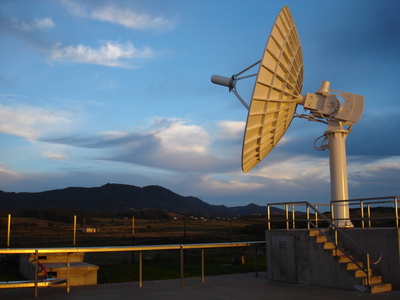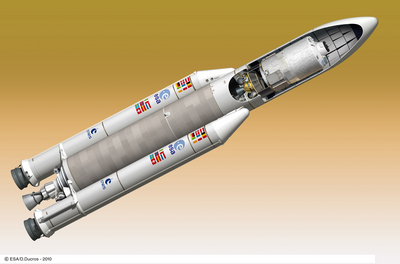Due to popular demand the ATV information kit has been translated into Spanish, and is available here. In its honour we will dedicate this post to Spain’s considerable contribution to ATV.
Ten Spanish companies have had their say in ATV production: Deimos Space, Alter Technology Group Spain, EADS Astrium Crisa, EADS CASA Espacio, GMV, GTD, Iberespacio, Indra Espacio, Rymsa and Thales Alenia Space España. Their contribution is visible in almost every aspect of ATV, from preparations to docking.
DEIMOS Space helped develop the simulation platform and validated the cargo ship’s software.

ESA's ESTRACK Santa Maria station
Indra Espacio designed and installed one of the tracking stations used on ATV missions. From the picturesque island of Santa María in the Azores they keep a close eye on ATV flight.
ATV tracking should not be problematic, as we know exactly what it will do and where it will be. In part this is down to GMV, a specialist in flight dynamics. They help to work out how ATV will behave during its flight. In addition to the flight dynamics they also conducted navigation studies for the ATV missions.
ALTER supplied electronic parts procurement services which means that they managed identifying, screening, selecting, negotiating and writing up contracts with all the different component suppliers around the world. Considering all the different parts used on ATV, this is a daunting task.

ESA's Automated Transfer Vehicle shown under the Ariane 5 payload fairing.
Before ATV arrives at the Space Station it needs to take off, of course. GTD modified the Ariane 5 launchpad to accomodate ATV ‘s weight, it is the heaviest spacecraft that the rocket has launched to date. In addition they modified the radar and flight safety systems at the Guiana Space Centre in preparation for ATV’s specific mission trajectories. They were also responsible for ATV’s rendez-vous and docking software.
EADS CASA Espacio assembled the supply ship’s structures as well as the system that seperates ATV from the Ariane rocket used to launch the spacecraft. Once an ATV has reached the correct height above Earth, explosive bolts are fired, liberating the spacecraft from the rocket and sending it on its way to the Space Station.
The next task for ATV is to approach the Space Station. Step up EADS Astrium Crisa, they manufactured part of the communications equipment for ATV’s approach manoeuvres. A “Communication Processor Formater” on the ISS and on ATV communicate with each other to assure a safe approach and docking.
Once ATV reaches the Station it needs to dock autonomously, this delicate procedure requires some communication with the Space Station as you can imagine. Thales Alenia Space España made some of the communications equipment for ATV’s docking manoeuvres. RYMSA contributed to some of ATV’s antennas allows the spacecraft to send and receive its messages.
Finaly the astronauts on the Space Station will be happy to know that Iberespacio did risk analysis to assess Station security. Iberespacio confirms that ATV will not endanger the Space Station and its inhabitants!

 Automated Transfer Vehicle page
Automated Transfer Vehicle page ATV blog archive
ATV blog archive
 NASA Orion page
NASA Orion page NASA Artemis
NASA Artemis Airbus Orion page
Airbus Orion page
Discussion: 3 comments
The information is wrong. Communication processor formatter (in the ATV) and Communication processor deformatted were done by Astrium Crisa and not Thales Alenia Space España.
You are right, thanks for spotting this mistake, I have changed the article.
How do you say “apologies” in Spanish?
Thank you Julien.
In Spanish we say, ‘mis disculpas’ or ‘lo siento’ 😉